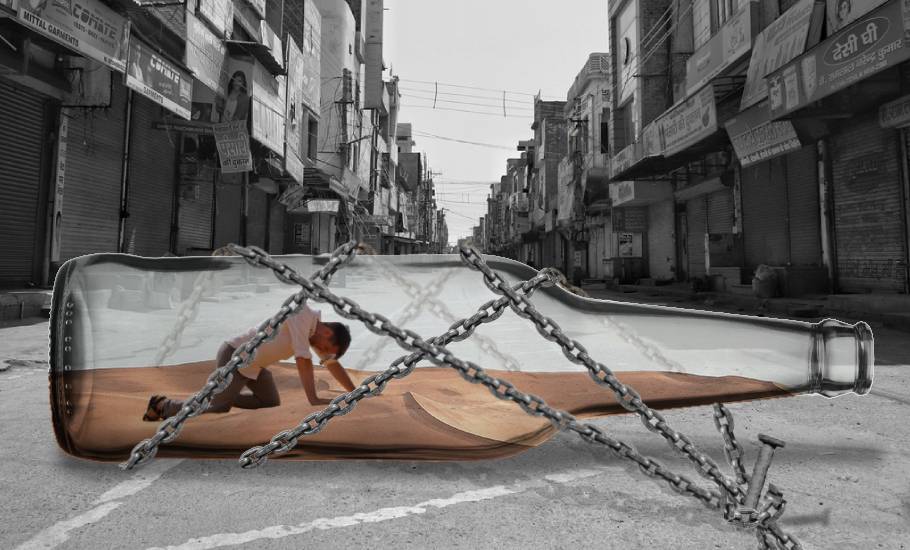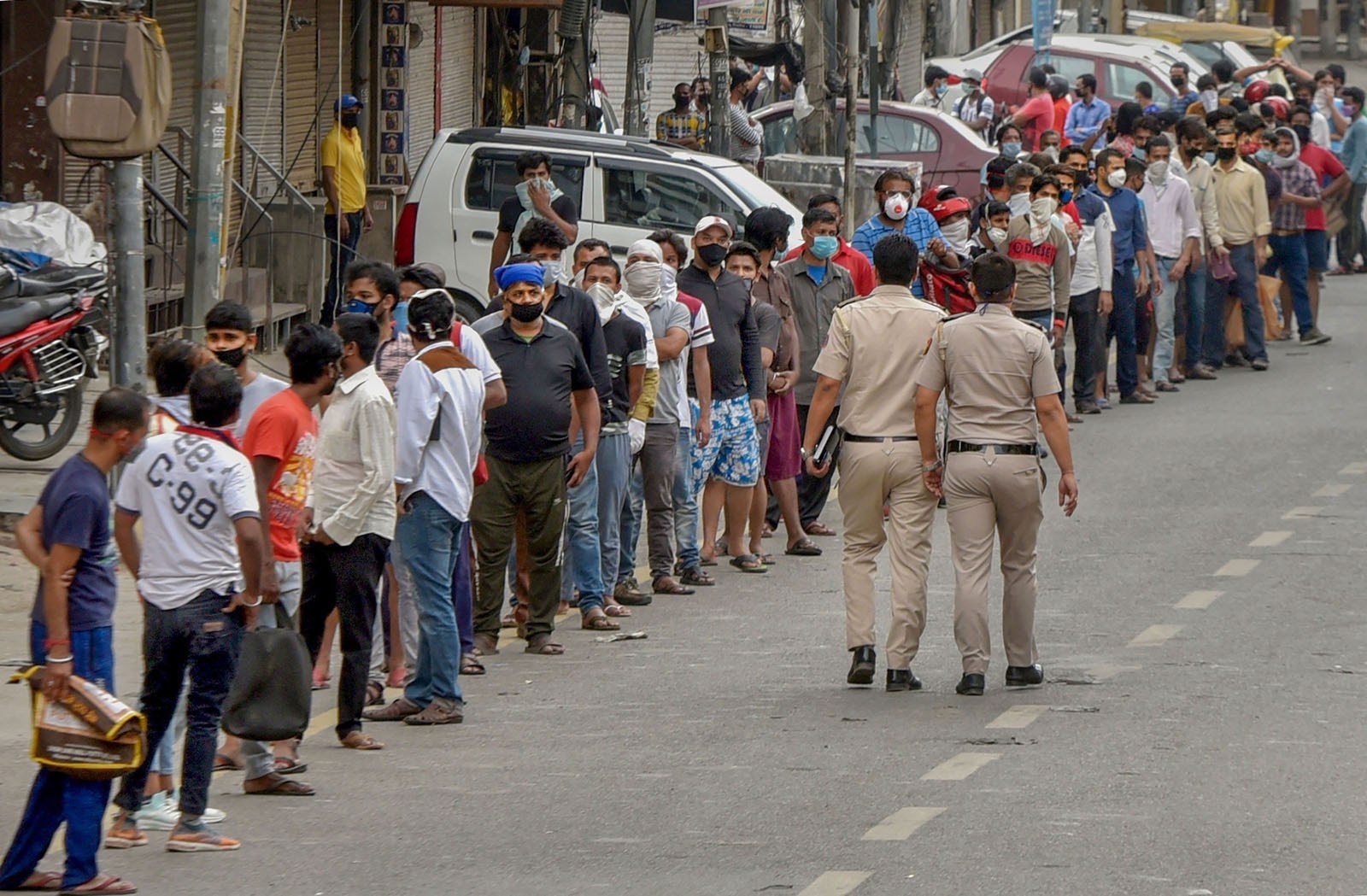
- Home
- News
- Analysis
- States
- Perspective
- Videos
- Education
- Entertainment
- Elections
- World Cup 2023
- Features
- Health
- Budget 2024-25
- Business
- Series
- NEET TANGLE
- Economy Series
- Earth Day
- Kashmir’s Frozen Turbulence
- India@75
- The legend of Ramjanmabhoomi
- Liberalisation@30
- How to tame a dragon
- Celebrating biodiversity
- Farm Matters
- 50 days of solitude
- Bringing Migrants Home
- Budget 2020
- Jharkhand Votes
- The Federal Investigates
- The Federal Impact
- Vanishing Sand
- Gandhi @ 150
- Andhra Today
- Field report
- Operation Gulmarg
- Pandemic @1 Mn in India
- The Federal Year-End
- The Zero Year
- Premium
- Science
- Brand studio
- Home
- NewsNews
- Analysis
- StatesStates
- PerspectivePerspective
- VideosVideos
- Entertainment
- ElectionsElections
- Sports
- Loading...
Sports - Features
- Budget 2024-25
- BusinessBusiness
- Premium
- Loading...
Premium

When liquor withdrawal in lockdown pushes tipplers to the edge
After 40 days of lockdown, the serpentine queues outside liquor shops across the country, disregarding social distancing norms, became a telling sign of the importance of alcohol consumption for thousands and the extent of addiction, even when a pandemic like COVID-19 was close on heels.

After 40 days of lockdown, the serpentine queues outside liquor shops across the country, disregarding social distancing norms, became a telling sign of the importance of alcohol consumption for thousands and the extent of addiction, even when a pandemic like COVID-19 was close on heels. Hilarious memes have been made of those waiting patiently for hours to get their ‘essential’ stock,...
After 40 days of lockdown, the serpentine queues outside liquor shops across the country, disregarding social distancing norms, became a telling sign of the importance of alcohol consumption for thousands and the extent of addiction, even when a pandemic like COVID-19 was close on heels.
Hilarious memes have been made of those waiting patiently for hours to get their ‘essential’ stock, after close to two months of abstinence.
However, for some, this is a serious issue. A few days into the lockdown, three men from a family approached the Institute of Mental Health, Chennai, with complaints of withdrawal symptoms, such as restlessness, nausea, headache and body ache. They were given medicines and sent back as they were unwilling to get admitted.
The same week, a man, who had been alcohol-dependent for the last 13 years, was brought in by his brother. The 30-year-old man from North Chennai had begun to hallucinate — hearing voices and seeing images — indicating severe withdrawal symptoms. He was treated with injections and given a week’s dosage of medicines and sent home after he too refused to get admitted, on the condition that they visit the facility if the symptoms recur and for a follow up examination in the next week.
Since the lockdown was imposed, there has been an extreme display of withdrawal symptoms. When Tamil Nadu reported five COVID-19 deaths in the first week of April, five other deaths were reported in the state in connection with withdrawal symptoms. The five men had consumed alternatives like varnish and soft drinks laced with aftershave lotion.
In Kerala, Vimukthi, a government-run programme (Kerala State Mission for De-addiction) that conducts awareness campaigns against alcoholism and drug abuse, has seen a steep rise in cases with withdrawal symptoms. Its helpline, 14405, saw a rise in calls from about 100 a month to 786 in the five week of lockdown. The calls spiked especially on the fourth and fifth day of the lockdown, March 28 and 29, when there were around 130 calls each.
D Rajeev, chief executive officer, Vimukthi says, “The calls began increasing from the day the lockdown was declared. A good number of them have realised the extent of addiction only during the lockdown. The callers mostly complained of shivering, sleeplessness and in extreme cases of withdrawal, they reported hallucinations.”
While some were referred to primary and community healthcare centres, others were directed to nearby hospitals. Rajeev adds, “The lockdown has actually revealed the true extent of addictions among the people in the state.”
Bengaluru-based National Institute of Mental Health and Neurosciences (Nimhans) too has reported a spike in the number of cases of alcohol withdrawal syndrome (AWS). In a study titled ‘Complicated Alcohol Withdrawal – an unintended consequence of COVID-19 lockdown’ it conducted, it was noticed that 96 middle-aged men suffering from severe AWS sought help between March 22 (when lockdown began in Karnataka) and April 11 as compared to 79 cases between March 1 and March 21, with or without seizures.
According to reports, 46 deaths have occurred in connection with alcohol withdrawal issues across the country during the lockdown. Experts say that the cases could be more going by the alcohol consumption rate in India.
Dr Lekhansh Shukla, assistant professor, Centre for Addiction Medicine, Department of Psychiatry, Nimhans, who worked on the study, says that along with AWS, one also has to factor in lack of transport, lack of awareness, malnourishment and the fact that medical help was not available, to understand the enormity of the condition.
Dr P Poorna Chandrika, director, IMH, says that they cannot claim a spurt in cases. “We did expect a steep rise and we had also sent out detailed guidelines for the same purpose.”
The low number of reported withdrawals could also be due to the restriction in movement, she feels.
Another source from the facility says that in the absence of a spike in numbers, they might have to think about reasons like the illegal access to liquor and arrack.
“That is also a worrying factor and it can harm them more,” the source adds. “It is like the tip of the iceberg. Many patients are reluctant to get admitted and make do with prescriptions for medicines that they can avail from PHCs nearby. It is only when family members accompany them are they willing to get admitted.”
Severity unacknowledged
Dr Shukla says withdrawal could also become extreme. “The patients lose a significant part of brain function and depend on others for their day to day activities,” he says.
He observes that reports of suicides among addicts is more likely to do with the effects of the withdrawal like seeing images and hallucinations of them being attacked by someone that result in them harming themselves either by jumping off a building or setting themselves ablaze.
The effect of AWS is more deadly when untreated, says Dr Shukla, who shares that the mortality rates are as high as 30%. “It is therefore more deadly than the COVID-19 and even in cases that receive treatment late, the mortality rate is 8%.”
Dr Lakshmi Vijayakumar, founder of SNEHA, a suicide prevention helpline, and a consultant psychiatrist at World Health Organisation (WHO), says that while the number of alcohol consumers in India is way low when compared to Western countries, even within the small group the level of addiction is higher.
“A higher number (of alcohol consumers) in the country also fall in the hazardous drinking category — they drink heavily, get drunk and are involved in accidents. All this goes to show that we haven’t looked into the social issue of the whole addiction and that these numbers have risen and are continuing to rise due to increasing social acceptance,” she explains.
What’s the government’s role?
For the government, liquor is a massive revenue generator. Especially in a crisis time as now, governments have gone ahead and either opened liquor stores or is delivering alcohol at the doorstep. In addition, the sure sales of the ‘essential’ has given them an impetus to charge a higher rate.
The government earns revenue from alcohol, knowing that the users are from the poorer sections of society and the same section relies on the government healthcare system, notes Dr Shukla. “This section doesn’t seek tele counselling or cannot navigate IVR systems and needs face to face consultations free of cost,” he stresses.
Dr Lakshmi adds that given the revenue generated by liquor sales, governments are reluctant to attend to the issue.
She notes that research has shown that reduction in the availability and consumption of liquor saves costs indirectly. “There are reduced accidents, lesser numbers requiring trauma and liver conditions,” she says.
In fact, limiting access to alcohol is also seen as a strategy to prevent suicides. She says, “One-third of suicides happen under the influence of alcohol.”
Y Aruldoss, anti-liquor activist, says states like TN should focus on rehabilitation measures rather than focusing on boosting revenue by opening TASMAC shops. “If these men can stay without alcohol for 40 or more days, then there is hope to reform them through treatment and deaddiction efforts,” he adds.
Dr Lakshmi too feels this is possible and cites the case of a watchman who was able to overcome the withdrawal after about seven days of not having had liquor.
Problems with rehabilitation
Experts argue that that one cannot explain the factors for addictions or consumption — it could be vocational reasons or social, psychological and in many cases, a combination of all. They also add that the deaddiction or rehabilitation process is all the more complex even if there is a will to change.

Dr Vivian Kapil, consultant psychiatrist, says, “In fact, the earlier definition of it being a moral disorder changed after experts understood that we cannot put our finger on one reason or cause for it. Similarly, even if they want to come out of it, it is never easy, as the brain circuits have been altered due to repeated drinking.”
In many parts of India, alongside government programmes, there are private rehabilitation centres that run deaddiction programmes that may not be successful, he says.
“The recovery of a person is never predictable and it is always better to intervene before they become complete addicts. A complete de-addiction programme runs with the help of social workers, counsellors, psychiatrists and medical physicians. Many of these are not equipped with the necessary experts and to add to it, beating and physically assaulting the person as part of treatment will never work,” he adds.
Treatment and guidelines
The state nodal officer of the Tamil Nadu District Mental Health Programme (DMHP), sent out guidelines for assessment of addiction in the last week of March. Under this, medical officers in PHCs, psychiatrists working in district hospitals and under the DMHP and psychiatry faculty in government medical colleges were roped in to execute the instructions that include dosage prescriptions for Chlordiazepoxide (a sedative and hypnotic drug used to treat withdrawal symptoms) in mild, moderate and severe cases of withdrawal.
“We plan to revise the guidelines with a more simple protocol to be sent to the departments concerned,” Dr Chandrika says.
On its part, the lessons Kerala has learnt from the lockdown scenario has prompted the government to step up treatment facilities.
Kerala is also now mulling over scaling up the number of beds in de-addiction wards of government hospitals in each of the 14 districts.
Rajeev adds, “We are also planning to start a satellite centre in each taluk, where a doctor and counsellor will attend to the cases and offer counselling. If they need further treatment, from there will be referred to the nearest deaddiction centre.”

